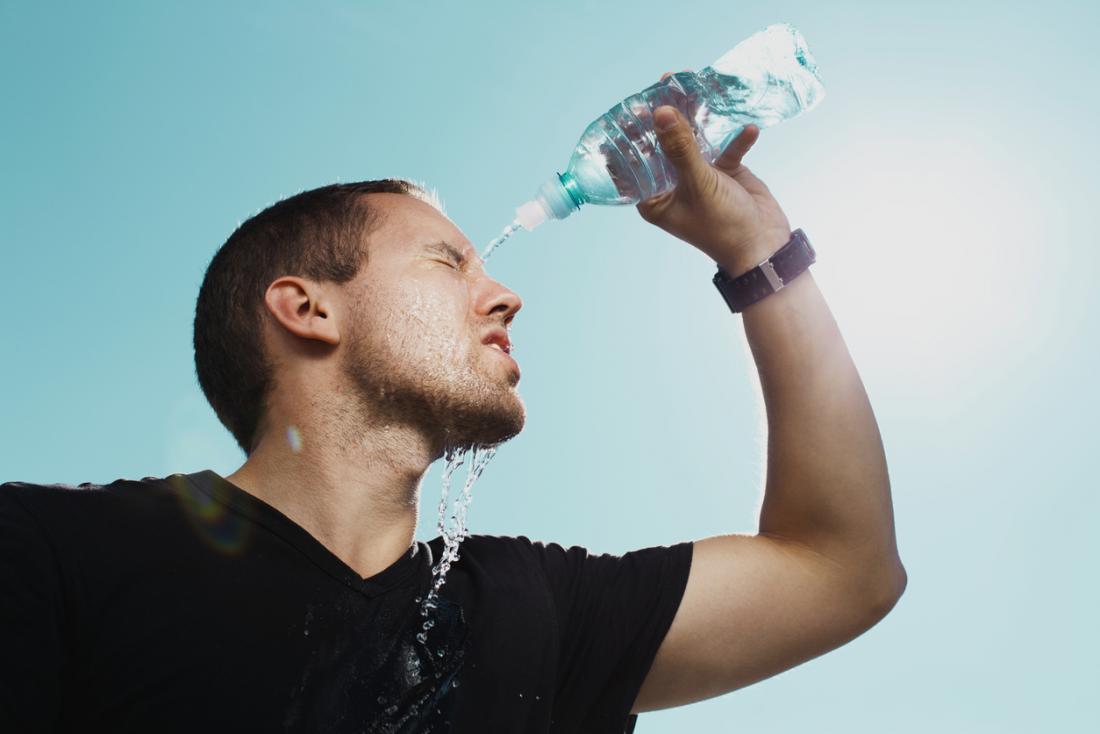Heat stroke is a very bad illness caused by the heat that can be fatal if it is not treated quickly. It happens when the body’s core temperature goes above 104 degrees Fahrenheit (40 degrees Celsius), which can happen after being in hot weather for a long time or doing a lot of hard physical work in the heat. Being overheated is called heat stroke, and it needs medical help right away. People of all ages can get it, but older people, young children, people who already have health problems, and players who do a lot of hard outdoor activities are more likely to get it. It is very important to know the signs of heat stroke and act right away to cool down and get medical help.
Causes of Heat Stroke
Heat stroke is a very dangerous and potentially fatal illness that happens when the body’s cooling system fails to keep the body’s temperature normal in very hot and muggy conditions or when doing a lot of physical activity in hot weather. Dehydration is the main cause of heat stroke because it makes it harder for the body to breathe and cool down.
When someone is dehydrated, their body loses salts and water that are needed to keep their body temperature stable. If you don’t drink enough water, your body can’t sweat as well, which stops sweat from evaporating from the skin’s surface and cooling you down. This can cause the temperature inside to rise too quickly, which is not safe.
People are more likely to get heat stroke if they are exposed to extreme heat and humidity for a long time, if they do strenuous physical activities in hot weather, or if they have a medical condition or take medicine that makes it harder for their body to control their temperature.
Having a high body temperature, hot and dry skin, a fast heart rate, and feeling confused are all early signs of heat stroke that you need to be aware of. As soon as possible, you should get emergency medical help, move to a cooler place with air conditioning if you can, and drink cool water or a sports drink to stay hydrated.
Staying refreshed, avoiding too much heat, wearing the right clothes, and taking breaks often in cool or shady places are all ways to avoid heat stroke. Remember that heat stroke is a serious medical issue that needs to be treated right away to avoid problems or even death.
Factors that contribute to heat stroke.
Heat stroke is a very dangerous illness caused by the heat that can be very bad if it is not treated right away. There are some things that can make someone more likely to get heat stroke. Age plays a big role. Babies, kids, and people over 65 are more likely to get it because their bodies can’t control their temperature as well.
Heart disease, diabetes, being overweight, and high blood pressure are just a few of the health problems that can make heat stroke more likely. People who take medicines like diuretics, sedatives, and antihistamines that make it harder for the body to cool down may also be more likely to get it.
The environment is also very important. Being out in hot weather, especially when it’s muggy, can make you more likely to get heat stroke. Performing intense physical tasks in hot weather, wearing too much clothing, and not having access to air conditioning or cool places all raise the risk.
It is important to be cautious if you want to avoid heat stroke. It is very important to stay refreshed by having lots of water, especially when it is hot outside or when you are working out. You can also lower your risk by wearing clothes that are light and airy and by staying inside during the hottest parts of the day. Getting some shade, using fans or air conditioning, and taking cool baths or showers can also help keep your body temperature safe. To avoid heat stroke and its possibly life-threatening effects, it is important to keep a close eye on people who are weak, like the old, people with long-term illnesses, and people who are taking certain medicines.
Common Indicators of Heat Stroke
Heat stroke is a serious illness caused by the heat that needs medical help right away. It happens when the body’s core temperature goes above 104 degrees Fahrenheit, which can happen after being in hot weather for a long time or working out in hot weather. Not sweating and having a high body temperature are two of the first signs of heat stroke. This is because sweating isn’t working properly as the body’s way of cooling down. Some other signs are skin that is hot and dry, a fast heartbeat, headaches, dizziness, nausea, confusion, and even passing out. People who have these signs should pay attention and act quickly to avoid more problems. Heat stroke is an emergency that can kill you, and you need to see a doctor right away to lower your body temperature and keep organs from getting damaged.
Early Signs of Heat Stroke
Heat stroke is a dangerous illness that can be life-threatening if the body can’t keep its core temperature in check. Knowing the early signs of heat stroke is important for getting medical help right away and avoiding more problems.
One of the first and most frequent signs of heat stroke is a headache. People may have a terrible headache that won’t go away, and it may get worse as the situation gets worse. Also, feeling dizzy or lightheaded is a red flag, especially if it happens after being outside in hot weather.
Another important sign of heat stroke is not sweating even though it is hot outside. Since sweating is the body’s natural way of cooling down, not sweating can mean that the process of controlling heat isn’t working right. People who have heat stroke often have weak muscles or cramps, which can happen in the arms, legs, or stomach.
Feeling sick and throwing up can also be early signs of heat stroke. There may be stomach pain or soreness along with these symptoms. It is very important to pay attention to these signs because they can get worse quickly.
If you or someone close to you gets any of these symptoms, you need to see a doctor right away. Heat stroke is an emergency that needs to be treated right away. Get immediate medical help by calling 911 or going to the nearest emergency room.
Remember that recognizing the early signs of heat stroke and getting medical help right away can save your life. Do not forget to be careful when it is hot outside to avoid getting sick from the heat.
Symptoms of Severe Heat Stroke
Heat stroke is not something you should take easily because it can be very bad for your health. It’s a medical emergency because it could hurt the brain and other parts inside the body. Heat stroke can happen quickly and without notice, even if there were no signs of heat damage before.
A core body temperature of more than 104 degrees Fahrenheit (40 degrees Celsius) is one of the signs of heat stroke. The body may not be able to handle this high temperature. As the illness gets worse, more dangerous signs may show up.
One of the worst signs of heat stroke is having seizures. These quick, out of control moves can be scary and are a sign that the body is under a lot of stress. People who have heat stroke often feel confused and lost as well. Some people may have trouble remembering simple facts or thinking clearly.
Heat stroke can be so bad that you lose awareness or even go into a coma. These are all signs of serious brain damage that need medical help right away. Another problem with heat stroke is that it can hurt organs inside the body. The high core body temperature can cause harm to organs such as the kidneys, liver, and heart.
Due to the potential for brain and organ damage, it is crucial to recognize and respond to the more serious symptoms of heat stroke. If you or someone around you experiences seizures, confusion, disorientation, loss of consciousness, or coma, seek emergency medical care immediately. Heat stroke is a medical emergency that requires prompt treatment to minimize the risk of long-term complications.
Immediate Solutions for Heat Stroke
When experiencing heat stroke, it is crucial to take immediate action to prevent further complications and potentially life-threatening emergencies. The first and most important step is to move to a cool, shaded area or an air-conditioned room. Remove any excess clothing to allow heat to escape from the body more easily. It is then essential to start cooling the body as quickly as possible. This can be achieved by applying cool water, preferably with the help of wet towels, or by taking a cool shower. Placing ice packs or cold packs on the neck, armpits, and groin area can also aid in lowering the body temperature. Furthermore, drinking cool fluids, such as water or sports drinks, can help rehydrate the body and regulate body temperature. However, it is important to avoid drinks with caffeine or alcohol as they can be dehydrating. While these immediate solutions can provide temporary relief, it is crucial to seek medical attention promptly to ensure proper medical treatment and to rule out any complications or underlying medical conditions. Heat stroke is a serious medical emergency, and timely intervention can make a significant difference in preventing further damage to the body.
Move to a Cool Place Immediately
When experiencing heat stroke, it is crucial to immediately move to a cool place. This immediate action helps in preventing further complications associated with heat-related illnesses and can be life-saving. Finding a cool environment is of utmost importance to regulate the body’s core temperature and alleviate the symptoms of heat stroke.
The first step is to locate shade if you are outdoors. Shielding yourself from direct sunlight can provide instant relief from the scorching heat. If shade is not readily available, it is advisable to seek refuge in an air-conditioned building. The cool air helps in reducing the body’s temperature and providing a much-needed respite from the heat.
In situations where an air-conditioned building is not accessible, finding a cool, well-ventilated area becomes crucial. This can be achieved by seeking refuge in a basement, a cellar, or any area that offers a cooler environment compared to the outside temperature. Placing wet towels on the body can also aid in cooling down.
It is essential to prioritize the immediate action of moving to a cool place as soon as heat stroke symptoms are evident. Delaying this step can exacerbate the condition and increase the risk of heat-related complications. Remember, finding a cool environment plays a significant role in the initial management of heat stroke and should not be overlooked.
Hydrate with Cold Water or Sports Drinks
Hydrating with cold water or sports drinks is crucial when experiencing heat stroke. One of the main dangers of heat stroke is dehydration, as excessive sweating can quickly deplete the body’s fluids. By drinking cold water or sports drinks, you can help prevent and treat dehydration effectively.
Drinking fluids is essential for restoring the body’s fluid levels, electrolytes, and salt balance, all of which can be disrupted during heat stroke. Cold water provides immediate relief and helps lower the body’s core temperature. Sports drinks, on the other hand, not only replenish fluids but also provide essential electrolytes that are lost through excessive sweating. They are particularly effective in maintaining electrolyte balance, crucial for optimal body function.
When it comes to infants and young children, Pedialyte is a recommended option. Pedialyte is specially formulated to replace lost electrolytes and fluids and is a safe and effective choice for preventing and treating dehydration in this age group.
Remember, hydrating with cold water or sports drinks should be done in addition to other immediate actions, such as moving to a shaded area and using wet towels to cool the body. Taking these steps promptly can help alleviate symptoms and prevent further complications during a heat stroke episode.
Loosen Clothing and Take a Cold Shower or Bath
When experiencing heat stroke, it is crucial to take immediate action to cool down the body. One simple and effective solution is to loosen clothing to allow for better airflow and ventilation. Removing excess clothing can help facilitate heat loss from the body.
Another immediate solution is to take a cold shower or bath. This helps to rapidly lower the body’s core temperature and provide relief from the symptoms of heat stroke. The cold water helps to cool down the body and reduce the risk of further complications.
Loosening clothing and taking a cold shower or bath work synergistically to bring down the body’s temperature and prevent heat-related illnesses from worsening. It is important to remember that heat stroke is a serious medical emergency and prompt action should be taken. Alongside these immediate solutions, it is recommended to seek emergency medical care for proper evaluation and treatment.
Apply Ice Packs or Cold Towels to the Skin
Applying ice packs or cold towels to the skin is an effective method of cooling down a person experiencing heat stroke. This should be done while waiting for emergency medical help, as it can help to lower the body temperature and reduce the risk of further complications.
To apply ice packs or cold towels, start by obtaining ice packs or wet towels with cold water. It is important to ensure that the ice packs are wrapped in a thin cloth or towel to prevent direct contact with the skin, which can cause frostbite. Alternatively, towels can be soaked in cold water and then wrung out to remove excess moisture.
Next, focus on applying the cold packs or towels to areas of the body with high blood flow, such as the neck, armpits, and groin. These areas have a higher concentration of blood vessels, allowing for more efficient heat transfer. Apply the packs or towels gently and leave them in place for a few minutes before reapplying. This process can be repeated as necessary to continue cooling the person down.
While applying ice packs or cold towels can provide temporary relief, it is important to remember that heat stroke is a medical emergency. Promptly seek emergency medical help for proper evaluation and treatment. These immediate solutions, along with medical care, can greatly increase the chances of a successful recovery from heat stroke.
Monitor Body Temperature and Heart Rate
When experiencing heat stroke, it is crucial to monitor body temperature and heart rate. These vital signs provide valuable information about the severity of the condition and guide immediate treatment.
Monitoring body temperature is essential because heat stroke occurs when the body’s core temperature rises above 104 degrees Fahrenheit (40 degrees Celsius). By regularly checking body temperature, you can determine if it is increasing or remaining elevated, indicating the severity of the heat stroke.
Monitoring heart rate is equally important because it can help identify the body’s response to heat stress. During heat stroke, the heart rate may become rapid or tachycardic. This increased heart rate is a sign that the body is working harder to cool itself down and may indicate worsening heat stroke.
Apart from monitoring body temperature and heart rate, some other signs and symptoms may indicate the progression of heat stroke. These can include rapid breathing, low or high blood pressure, dizziness, confusion, nausea, and even loss of consciousness. If you notice any of these symptoms, it is crucial to seek immediate medical attention as they may indicate a life-threatening emergency.
Conclusion
In conclusion, taking immediate action when experiencing heat stroke is crucial to prevent further complications and ensure prompt treatment. Delaying treatment for heat stroke can have serious risks and consequences for the individual’s health and well-being.









